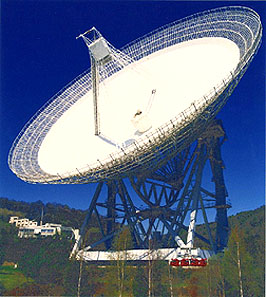text by Gerd Weigelt
 Effelsberg The 100m Effelsberg radiotelescope, built and operated by the MPIfR The main areas of work of the MPIfR are Radio- and Infrared Astronomy. Technological work at the institute covers the whole spectrum from radio-, via (sub)millimeter-, to infrared wavelengths. Research areas include star formation, stars in late stages of their evolution, pulsars, the interstellar medium of our Milky Way and external galaxies, the Galactic Center and its environment, magnetic fields in the universe, radio galaxies, quasars and other active galaxies, dust and gas at cosmological distances, galaxies in the early epochs of the universe, cosmic rays, astroparticle physics, and the theory of star formation and active galactic nuclei.
Effelsberg The 100m Effelsberg radiotelescope, built and operated by the MPIfR The main areas of work of the MPIfR are Radio- and Infrared Astronomy. Technological work at the institute covers the whole spectrum from radio-, via (sub)millimeter-, to infrared wavelengths. Research areas include star formation, stars in late stages of their evolution, pulsars, the interstellar medium of our Milky Way and external galaxies, the Galactic Center and its environment, magnetic fields in the universe, radio galaxies, quasars and other active galaxies, dust and gas at cosmological distances, galaxies in the early epochs of the universe, cosmic rays, astroparticle physics, and the theory of star formation and active galactic nuclei.The institute is heavily involved in a number of large international projects:
- the US-German Stratospheric Observatory for Infrared Astronomy (SOFIA)
- the Atacama Pathfinder Experiment (APEX): development and operation of a submillimeter telescope in the Atacama desert of Chile under MPIfR leadership
- the US-European Atacama Large Millimeter Array (ALMA)
- the Far-Infrared and Submillimeter Telescope satellite observatory HERSCHEL (formerly known as FIRST),
- an upgrade of the Effelsberg 100-meter radio telescope,
- the conception of a next-generation radio telescope with a collecting area of one square kilometer (Square Kilometer Array, SKA),
- the Very Large Telescope Interferometer (VLTI) in Chile (AMBER),
- the US-European Large Binocular Telescope (LBT) in Arizona, and
- the continuation of Very Long Baseline Interferometry (VLBI) to millimeter wavelengths and to extremely high angular resolution using antennas in space.
History of the Institute
- 1966 foundation of the institute. Construction of the 100-meter radio telescope in Bad Münstereifel-Effelsberg
- 1972 start of operations. Development and operation of the 10-meter submillimeter telescope (Heinrich-Hertz-Telescope) jointly with Steward Observatory.
- 2001 start of the APEX project.
Contact :
Max-Planck-Institut fuer Radioastronomie
Auf dem Huegel 69
D-53121 Bonn
Germany
Tel +49 (0)228 525 0
Fax +49 (0)228 525 229
Web site: http://www.mpifr-bonn.mpg.de


